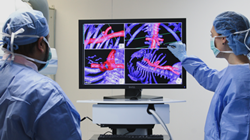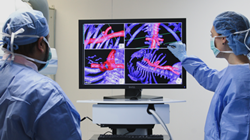
Led by Satish Muluk, MD, director of vascular surgery at AGH, AHN will be the first health system to offer this technology in the state
“IOPS is an exciting breakthrough in the field. This advanced technology significantly improves the accuracy of catheter placement, reducing procedural time and minimizing patient and healthcare provider exposure to harmful radiation,” said Dr. Muluk.
PITTSBURGH (PRWEB)
October 22, 2021
A team of vascular surgeons at Allegheny General Hospital (AGH), part of Allegheny Health Network (AHN), is one of the first in the country to advance the care of complex aortic aneurysms by utilizing a cutting-edge intra-operative positioning system (IOPS) by Centerline Biomedical. The minimally invasive, technology platform creates three-dimensional perspectives of the vascular system to improve navigation, quickly locate aortic aneurysms and precisely implant stent grafting to perform complex endovascular aortic interventions.
Led by Satish Muluk, MD, director of vascular surgery at AGH, AHN will also be the first health system to offer this technology in the state. In addition to Dr. Muluk, Drs., Bart Chess and Carlos Rosales of the AHN Cardiovascular Institute also perform the procedure using IOPS.
Abdominal aortic aneurysms (AAA) are weakened sections of an artery wall, in the lower part of the aorta, which cause the area to bulge beyond a blood vessel’s normal width. They’re typically managed with close monitoring, medical therapies and modifications of certain lifestyle factors.
However, if the AAA is at risk of a life-threatening rupture or significantly increases in size, patients will undergo either open or minimally invasive endovascular procedures to repair the aneurysm. During the latter, a vascular surgeon goes through the groin with a catheter and places a stent within the aorta which allows for eased blow flow and results in a decompression of the aneurysm.
The procedure requires significant navigation from the point of entry through the vascular system to the abdominal area. To view the aneurysm and accurately perform the repair, physicians have to use fluoroscopy — imaging that’s like an X-ray — and also inject an iodine-based contrast agent into the patient to see their blood vessels clearly.
“Previously, we would navigate catheters and wires through the body and rely primarily on fluoroscopy and dyes. This method has served us well, but it involves a lot of radiation exposure to the patient and the clinicians in the operating room,” explained Dr. Muluk. “IOPS is an exciting breakthrough for the field as it allows for improved visualization of the vascular system. This advanced technology significantly improves the accuracy of catheter placement, reducing procedural time and minimizing patient and healthcare provider exposure to harmful radiation.”
IOPS uses a low-intensity electromagnetic tracking system, or a GPS-like guide, to help surgeons navigate to a patient’s aortic aneurysm. The program uses pre-op CT scans to generate a computerized map of the anatomy and blood vessels.
The IOPS cart is wheeled into the OR and attaches to the tracking system that’s located on the operating table. The OR team places the tracking pad — a sticky device with three clear sensors — onto the patient in the location of the aneurysm; from there, the process mimics the existing process provided by fluoroscopy.
“IOPS technology gives us a three-dimensional view of the vascular system during the entire procedure rather than our current two-dimensional view, and we also have added control of the instrumentation,” continued Dr. Muluk. “The tracking system on the table under the patient has a grid that can sense the catheters and wires that we place into the patient, all in real time.”
The increase of clarity has proven highly effective in minimizing radiation and significantly reducing procedure times. A recent study, conducted by Centerline, found that the mean time necessary to introduce thin tube through an artery using 3D navigation was nearly cut in half compared to 2D.
According to the Society for Vascular Surgery, every year approximately 200,000 people in the U.S. are diagnosed with AAA, and its rupturing is among the top 20 leading causes of death in the country and the 10th leading cause of death in men older than 55.
“We are thrilled to partner with Dr. Muluk and Allegheny General Hospital’s world class Cardiovascular Institute and believe our IOPS technology addresses four key tenets of healthcare today: improved patient experience, improved health of populations, reducing healthcare costs, and minimizing staff burnout,” said Centerline CEO Phil Rackliffe.
To make an appointment or learn more about the AHN Cardiovascular Institute, please visit ahn.org or call 412-DOCTORS.
###
About the Allegheny Health Network:
Allegheny Health Network (AHN.org), a Highmark Health company, is an integrated healthcare delivery system serving the greater Western Pennsylvania region. The Network is composed of 13 hospitals, ambulatory surgery centers, Health + Wellness Pavilions, an employed physician organization, home and community-based health services, a research institute, and a group purchasing organization. The Network provides patients with access to a complete spectrum of advanced medical services, including nationally recognized programs for primary and emergency care, trauma care, cardiovascular disease, organ transplantation, cancer care, orthopedic surgery, neurology and neurosurgery, women’s health, diabetes, autoimmune disease and more. AHN employs approximately 21,000 people, has more than 2,500 physicians on its medical staff and serves as a clinical campus for Drexel University College of Medicine and the Lake Erie College of Osteopathic Medicine.
Share article on social media or email:

